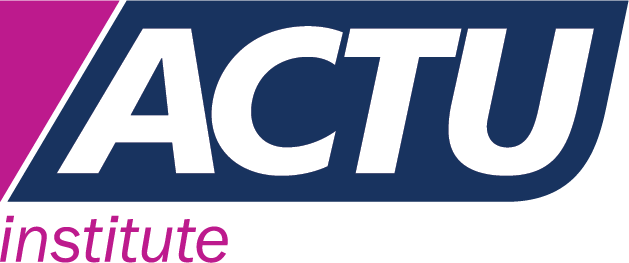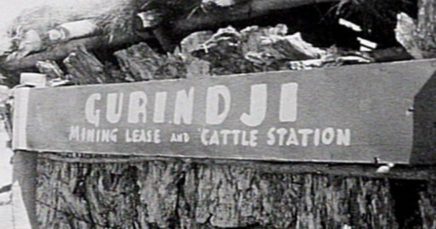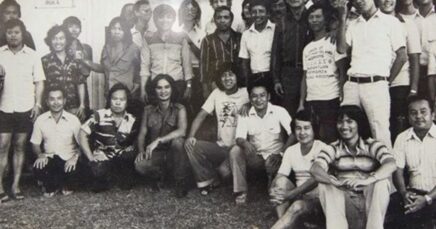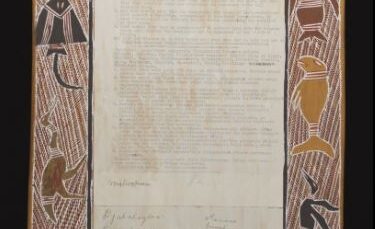Aboriginal and Torres Strait Islander readers are advised that this page does contain the images of deceased persons.

Aboriginal and Torres Strait Islander unionists have a long and proud history of making change in the struggle against racism, for recognition, and for self-determination.
Change in Australian society, politics, and the economy. And change in the union movement itself.
The Australian union movement has been transformed for the better by the actions of Aboriginal and Torres Strait Islander union members who have led struggles and changed attitudes.
The union movement also has a proud record of non-Indigenous members demonstrating practical solidarity with their Aboriginal and Torres Strait Islander comrades.
This year we seek to build on that history with the Voice campaign.
To do so the union movement needs to begin with an open and honest acknowledgement that we have not always lived up to our defining principle of solidarity. There are too many times when the union movement has been exclusionary to Aboriginal and Torres Strait Islander peoples and actively participated in the processes of dispossession.
This is also a part of our history that the movement cannot forget and must never excuse.
As Aboriginal and Torres Strait Islander unionists and allies in the broader movement come together to make history this year, it is important to remember the proud legacy left before us.
This is a short history of just some moments from the extraordinary struggles by Aboriginal and Torres Strait Islander unionists that have transformed the union movement. It focuses on two particular events of relevance to everyone campaigning for justice this year: union involvement in the 1967 referendum, and the Partners for Justice conference of 1993.
Aboriginal and Torres Strait Islander organising and resistance in the twentieth century
Aboriginal and Torres Strait Islander peoples have a long and proud tradition of collective action and political organising to resist dispossession and to assert their fundamental right to control their own lives.
This began with resistance to the initial colonisation and continued all through the nineteenth century with heroes such as William Barak who led the campaign at the Coranderrk Mission against the racist intrusion of colonial authorities who sought to control all aspects of the lives of Aboriginal residents there.
One of the most significant early political organisations was the Australian Aboriginal Progressive Association (AAPA) formed in New South Wales in 1924.
The AAPA was founded by activists such as Fred Maynard and Tom Lacey, both also wharfies and members of the Waterside Workers’ Federation (WWF).
The AAPA campaigned against racism and for justice. Harassment from the police and state government authorities eventually forced the organisation to disband, but it left a proud legacy of activism.

12 years later, in Melbourne, the legendary William Cooper led the foundation of the Australian Aborigines League (AAL).
Mr Cooper was a former shearer and member of the Australian Workers’ Union (AWU) – and he had been one of the unionists involved in the 1890s shearers’ strikes.
In the 1930s Mr. Cooper led a petitioning campaign that called upon King George V to grant “our people representation in the Federal Parliament…”
In 1937 Bill Ferguson, also a former shearer and once an organiser for the AWU, played a leading role in founding the Aborigines Progressive Association (APA).
The following year, Cooper and Ferguson helped organise the ‘Day of Mourning’ – a massive protest event to mark the 150th anniversary of the colonisation of Australia.
These political organisations had an ongoing and enduring significance to the struggle for justice.
This was also a time of collective actions by Aboriginal and Torres Strait Islander peoples seeking to reclaim control over their own lives from the racist agencies of the state.

In 1936, Torres Strait Islander workers in the maritime industry took strike action over many months to protest the racist authority of the so-called government “Protector”. Their heroic action removed the “Protector” and inspired changes that allowed greater control over their own lives.
From 1946 – 1949 Aboriginal pastoral workers in the Pilbara took strike action for better pay and conditions, but also to assert their rights to determine their own destinies. The Seamen’s Union of Australia supported the strike, and in 1949 its members imposed a ban on products made on pastoral stations where Aboriginal workers were striking.
From 1950-1951 Aboriginal workers at the Berrimah reserve, just outside of Darwin, went on strike with the support of the North Australin Workers’ Union for Equal Pay. Aboriginal leaders, such as Fred Waters, were arrested and forcibly removed from Berrimah, sent into effective exile. More than 30 unions took up the cause in support of Waters and his fellow strikers.
In 1957, Aboriginal workers on Palm Island were led by the ‘Magnificent Seven’ strike leaders for five days of collective action. The strike only ended when its leaders were arrested and deported from the island at gunpoint.
These are just some examples of the many heroic actions undertaken by Aboriginal and Torres Strait Islander workers in this era.
FCAATSI
In 1958, a number of state and territory-based advocacy and activist groups came together to form a new organisation: the Federal Council for Aboriginal Advancement. In 1964 this was renamed the Federal Council for the Advancement of Aborigines and Torres Strait Islanders (FCAATSI).
In the early days of the organisation its leadership was predominantly non-Indigenous, though by 1962 structural changes would see an Aboriginal President and a majority of Executive members being Aboriginal or Torres Strait Islander peoples.
Some of the organisations that would later form FCAATSI had run a petitioning campaign in the late 1950s around the issues that would come to be addressed in the 1967 referendum. Between this time and 1967 at least four major petitioning drives were held to elevate the issues facing Aboriginal and Torres Strait Islander peoples in the public consciousness.
The most influential petition campaign was organised by FCAATSI in 1962. Over 100,000 people signed a FCAATSI petition as part of this drive. In 1963, for a period of seven weeks, every sitting in the House of Representatives began with the tabling of these petitions.

FCAATSI and NTCAR influencing the union movement
In 1962, Aboriginal and union activist Joe McGinness was elected FCAATSI President – the first Indigenous president of the organisation.
McGinness was Secretary of the Cairns Aborigines and Torres Strait Islander Advancement League (CATSIAL), and an activist with the Waterside Workers’ Federation.
CATSIAL led campaigns in the local area against discrimination and for equality, often with success.
McGinness pushed for closer connection between FCAATSI and the union movement.
FCAATSI formed a special subcommittee on Wages and Employment, which had the specific aim of putting the ‘disgraceful position of Aboriginal workers before the ACTU.’

The other organisation of particular note in its organising at this time was the Northern Territory Council for Aboriginal Rights (NTCAR).
The NTCAR had been founded in 1961 and affiliated with FCAATSI the following year. In contrast to many other activist organisations that campaigned around Aboriginal and Torres Strait Islander issues, the majority of its membership was Indigenous.
It was led by Davis Daniels, its first secretary and his brother Dexter Daniels, later the Aboriginal Organiser of the North Australian Workers’ Union. Brian Manning, the legendary non-Indigenous union activist, also played an integral role as part of the NTCAR.
NTCAR campaigned for wage equality, especially in the pastoral industry which was notorious for the racial discrimination shown to Aboriginal workers.
A crucial element of its activity was pushing unions such as the NAWU and AWU to actively campaign for wage equality in the industry.
The ACTU Congress of 1963
The efforts of these Aboriginal and Torres Strait Islander unionists and activists, and the solidarity of their non-Indigenous supporters in the movement, had a significant effect on the policies of the Australian union movement.
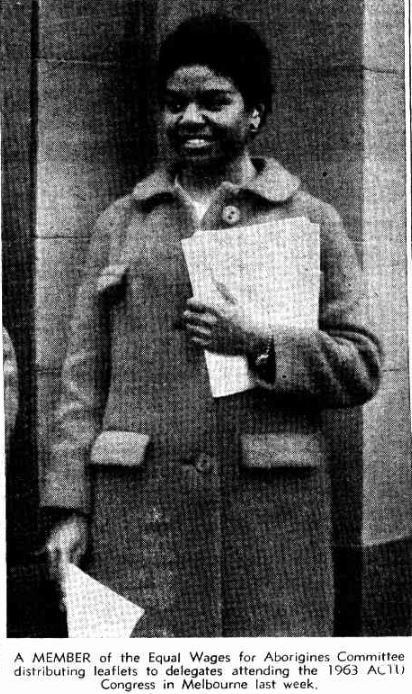
The most notable demonstration of this took place at the 1963 ACTU Congress, where FCAATSI members had been pushing for the union movement to adopt a substantive policy for equality.
When delegates arrived at the Congress, they were met by eager members of the FCAATSI Equal Wages Committee distributing pamphlets and leaflets revealing the scale of exploitation Aboriginal and Torres Strait Islander workers experienced.
There was resistance to this change within the movement, but also very strong support.
Eight different unions and Trades and Labour Councils submitted motions on Aboriginal and Torres Strait Islander policy.
The motion that was adopted at the Congress read:
“Congress declares that it is the natural right of the Aboriginal people of Australia to enjoy a social and legal equality with other Australians.”
“Congress supports the current petition for a referendum to amend the Constitution.
(a) (Section 51 XXVI) to include the Aboriginal Race; and
(b) (Section 127 to include Aboriginal people in the Census.
Congress calls on all State Governments that have not done so to grant full rights to all aborigines.”
The Congress motion also declared:
“There must be an end to wage discrimination.”
This pledged the union movement to the campaign to amend the constitution that would become the 1967 referendum and to support the campaign for wage equality.
Moves towards a referendum
The ACTU’s support was significant in building momentum for a referendum. But, ultimately, it would require the government of the day agreeing to a vote for any change to take place.

Unfortunately for Aboriginal and Torres Strait Islander activists, the government of the day was the conservative Coalition led by Robert Menzies – ardently opposed to change.
Joe McGinness would later recount a FCAATSI delegation that met with Menzies to advocate for a referendum:
“We made it very clear that, as seen by us on the deputation, it was painful ironical that while a census of sheep and cattle in the country was taken and the official population number declared annually, the Aboriginal population was excluded from the exercise, and no accurate figure could be given of our numbers, which meant that animals introduced into the country had priority” over Indigenous peoples.”
Under the domestic pressure generated by FCAATSI and other campaigners, and also increasingly isolated internationally due to the inequality with which Aboriginal and Torres Strait Islander peoples were treated, the Coalition Government (by now led by Harold Holt) eventually decided a referendum would be held on 27 May, 1967.
The Wage Equality campaign
The move towards a referendum came in the context of growing activism for wage equality for Aboriginal and Torres Strait Islander workers, spearheaded by organisations such as FCAATSI and NTCAR who now pushed unions to take action in line with the 1963 ACTU Congress policy.
In 1965 the industrial tribunal – known as the Arbitration Commission – agreed to hear a case launched by the NAWU that would provide wage equality to Aboriginal workers in the pastoral industry.
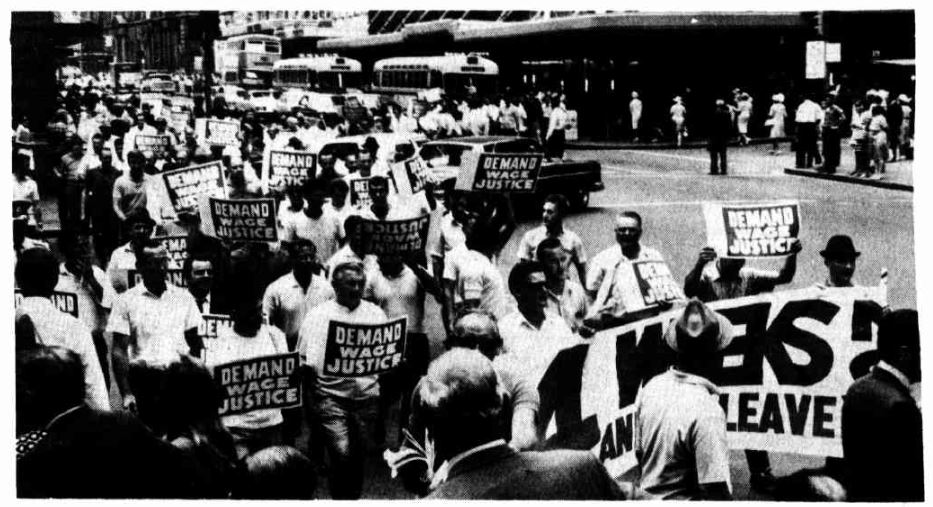
In a sign of the racism of the time, not one Aboriginal worker spoke during the entirety of the case’s hearings. Instead, they could only observe the white litigators debate the value of their labour.
In this context, it must be said that the NAWU’s failure to call any Aboriginal workers to provide testimony during its case was a moral as well as strategic mistake.
The Commission’s hearing was indicative of the colonial attitudes of the time. The vast bulk of witnesses called were white station owners. These owners belittled the quality and character of the Aboriginal labourers upon whom their enterprises depended.
Outside of the tribunal rooms themselves, FCAATSI and union allies led a sustained campaign of public pressure, including protests, production of pamphlets, public meetings, and a mail-in letter writing campaign to the Commission.
The Trades Hall Council circulated its affiliates with requests for funds to produce leaflets on wage discrimination and individual unions provided space in their newspapers and publications for the Committee. The Seamen’s Union took the lead in arranging for the printing of a national petition calling for all Aboriginal workers to receive ‘at least the basic wage’.
It produced an issued a special pamphlet on “The Facts on Wage Discrimination Against Aborigines” to distribute at the beginning of the Commission’s hearings. The Trades Hall Council funded the printing of 32,000 copies.
Ultimately, the Commission ruled to end wage inequality. But in a racist insult to Aboriginal workers it delayed the implementation of this equality until December 1968.
Its judgement explicitly stated that this was to provide the station owners the opportunity to replace Aboriginal workers with white labour.
Aboriginal workers were determined not to wait for equality.
Supported by Mr Daniels, workers at the Newcastle Waters cattle station went on strike on 1 May 1966 demanding equal pay.
The North Australian Workers Union banned Mr Daniels from taking further action and extending the strikes. Mr Daniels refused, took leave from the union, and went right on organising.
In June, Gurindji workers at the Wave Hill station, led by the legendary Vincent Lingiari, began a walk off that would ultimately last for nine years. Mr Daniels played an integral role supporting the struggle.

The Gurindji strike began as a protest for equal wages, but very quickly it became clear it was part of a larger struggle: the struggle for land rights.
It was led and sustained by the heroism of the Gurindji themselves. But the trade union movement played a significant role in supporting the Gurindji across these nine years.
The trade unionist Brian Manning, of the Waterside Workers Federation, volunteered on multiple occasions to drive supplies the 750 kilometres from Darwin to Wattie Creek.
Mr Daniels and fellow-activist Lupna Giari conducted a speaking tour sponsored by the Building Workers Industrial Union and Actors Equity, addressing sixty meetings in just over a month in which they explained their cause.
The Australasian Meat Industry Employees Union placed a ban on any products being produced by replacement labour at Wave Hill.
Other unions held mass meetings, raised collections to support the strikers, and pressured politicians to act.
In August of 1975, Labor Prime Minister Gough Whitlam symbolically poured earth from the Gurindji land into the hands of Vincent Lingiari, and presented a leasehold over part of their land.
The 1967 referendum campaign
The struggle for wage equality and against racist discrimination was a vital part of the context in which the 1967 referendum took place.
The historian of FCAATSI, Sue Taffe, described the FCAATSI Yes campaign as ‘sophisticated and wide-reaching’.
Leading Aboriginal activists such as Joe McGinness, Oodgeroo Noonuccal (known at the time as Kath Walker), and Doug Nicholls played a prominent role in the campaign, speaking on the exclusions and discrimination that Aboriginal and Torres Strait Islander peoples experienced across Australia.
McGinness later recalled the mass meetings of trade unions, church groups, and community organisations that were held as part of the campaign across Australia.
He and his fellow campaigners spoke of the need to extend the ‘fair go’ to Aboriginal and Torres Strait Islander peoples who had long been denied it – a message with deep resonance throughout the community.
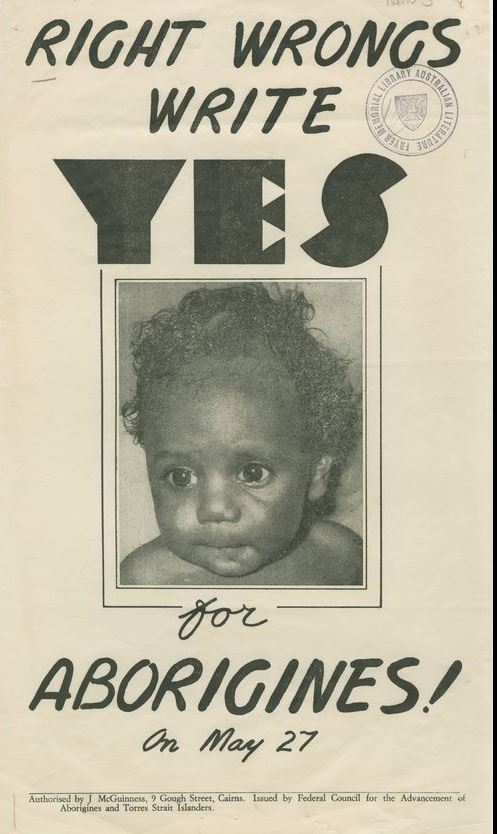
When a referendum is held, the government is required to produce a pamphlet outlining both the Yes and No case on the question. In 1967 all the political parties endorsed the Yes vote, so there wasn’t a published No case.
On 27 May, 1967, 90.77% of voters wrote YES on their ballot papers in a national referendum to change Australia’s constitution.
This remains the highest YES vote ever recorded in a referendum in Australia.
There were two specific changes being voted on.
The first was to repeal Section 127 of the constitution, which stated that Aboriginal and Torres Strait Islander peoples would not be counted as part of the Australian population in any census.
The second change was to Section 51 (xxxvi) of the constitution. Before the referendum this section read: “The parliament shall, subject to this Constitution, have power to make laws for the peace, order and good government of the Commonwealth with respect to the people of any race, other than the aboriginal race in any State, for whom it is deemed necessary to make special laws.”
As a result of the referendum, the sentence “other than the aboriginal race”was deleted from this section.
The overwhelming Yes vote was welcomed at the time as a unifying statement of inclusion.
The significance of the 1967 referendum
There are huge debates over the precise meaning and significance of the 1967 referendum.
There are many misunderstandings about just what the referendum promised, and what it delivered.
A large reason for this is that the 1967 referendum is often extracted from its broader context. Without knowing the fuller history, it is impossible to really understand what happened that year.
The 1967 referendum was of huge symbolic significance and deep emotional resonance for large numbers of Aboriginal and Torres Strait Islander peoples who campaigned for constitutional change.
The legendary Aboriginal activist Bill Onus, a former shearer and AWU member, who was the referendum campaign director in Victoria, said of the vote: “In this year of our Lord, nineteen hundred and sixty seven, we cannot help but wonder why it has taken the white Australians just on 200 years to recognise us as a race of people.”
The referendum itself did not provide citizenship rights to Aboriginal and Torres Strait Islander peoples.
Many of the rights associated with citizenship had been won in separate and hard-fought campaigns before the referendum, including the right to vote in 1962, and the right to equally access social services in 1966, among others.
The right to wage equality – a basic, though often neglected, citizenship right – was still being campaigned for (this remains the case today).
Many non-Indigenous supporters of the referendum seem to have believed that the vote alone would deliver greater equality immediately.
But large numbers of Aboriginal and Torres Strait Islander activists appreciated that it was better understood as another step in a much broader and longer struggle.
Struggle in the 1970s
The activism and struggle of Aboriginal and Torres Strait Islander peoples had elevated Land Rights to the status of national debate.
The Gurindji strike mobilised Aboriginal and Torres Strait Islander activists and their union supporters across the country for the return of their land.
In response to this growing pressure Coalition Prime Minister Billy McMahon delivered a speech on the 26th of January 1972 stating he would never deliver Land Rights.
This spurred the Aboriginal Tent Embassy protest of that year.

The legendary Aboriginal activist and historian Dr. Gary Foley noted that:
“This idea had already been floated a couple of times the previous year by Chicka Dixon, an admirer of the 1968 Occupation of Alcatraz Island by the American Indian Movement. It had been a spectacular stunt.”
Dixon was a former Wharfie and WWF member who had been actively involved in FCAATSI, and would also play a leading role in establishing the Aboriginal Legal Service in Redfern.
The tent embassy was an extraordinarily creative and courageous protest action, defying state intimidation and police harassment.
While the tent embassy was a protest very much led by Aboriginal activists, it was supported by some allies in the union movement. Dr Foley recalled:
“These sorts of alliances were being made all over the place, especially in the trade union movement. We developed a strong relationship with the NSW Builders Labourers Federation (BLF), under Jack Mundey, Bob Pringle and Joe Owens. In fact, the BLF enabled Billy Craigie and myself to address the NSW Trades and Labour Council’s meeting to seek support for the Aboriginal Embassy.”
Connecting the movements
Some trade unions were playing a more and more active role in supporting Aboriginal and Torres Strait Islander members and taking up issues important to them in this era.
Kevin Cook, the legendary Aboriginal educator and activist, became a delegate and then organiser with the BLF in this era.
At this time the BLF placed a ban on the proposal to redevelop a section of Redfern known as ‘The Block’, which many vulnerable community members relied on for shelter.
BLF members refused to do any demolition or construction work on the area, in effect, preventing any new developments that would displace inhabitants. The Whitlam Government later funded the Aboriginal Housing Corporation’s purchase of the Block.

Cook went on to lead the Aboriginal and Torres Strait Islander educational collective, Tranby.
Tranby was strongly supported by trade unions. The Waterside Workers’ Federation and Seamen’s Union of Australia were particularly prominent supporters, with the current Maritime Union of Australia General Secretary, Paddy Crumlin, just one of many waterside union leaders to have served on the Tranby Board.
Tranby was also an organisational hub for Aboriginal campaigns on issues such as Land Rights, Deaths in Custody, and justice for the Stolen Generations. Tranby played a central role in the organising that led to the massive protests at the 1988 Bicentennary (supported by a number of unions).
Cook also played an integral role at this time in founding the Trade Union Committee on Aboriginal Rights (TUCAR), based initially at Tranby, which provided a point of connection between Aboriginal political activists and campaigns with the union movement.
Cook worked alongside unionists such as Meredith Burgmann of the Union of Academic Staff, Rod Pickette of the Australian Theatrical and Amusement Employees Association, and Sergio Zorino of the Federated Engine Drivers’ and Fireman’s Association.
Soon TUCAR was meeting at the NSW Trades and Labor Council and was playing an active role in ‘informing unions about Aboriginal goals and seeking union support for Aboriginal campaigns.’
Cook later recalled the significance of TUCAR’s meetings:
‘… when TUCAR [was] meeting at Tranby, the students would be involved because they’d see white people coming into the organisation, sitting down and they could sit there with them. And they could see that the white people weren’t leading the discussions. At the TUCAR meetings, the Aboriginal people would lead the discussions and the trade union movement would back them. That’s what we asked them to do.’
Among the most significant issue TUCAR asked unions to get active on was Land Rights.
The NSW Labor Government of Neville Wran had set up a select committee in 1980 on the topic. In 1981 this committee recommended action on Land Rights, but it seemed that the Government itself was intending to ignore this recommendation. TUCAR became a key means to mobilise union support , including forming a delegation in May 1981 to the premier. Cook recalled an initial hope that 5 unions could be mobilised. 15 committed to the delegation.
In 1985, Cook and fellow Aboriginal activists used ACTU and Teachers’ Federation support to take the issues of Indigenous rights to the International Labour Organization, leading to significant change to its understanding of Indigenous peoples and their struggles.
Aboriginal and Torres Strait Islander issues were gaining greater prominence across the movement as a result of the actions undertaken by Indigenous unionists themselves.
The work being done at Tranby provided a nexus point set just outside any individual union for networks to be forged of Aboriginal and Torres Strait Islander unionists seeking to make change, outside the movement, and within.
And unions themselves were being transformed because of these efforts.
In 1985 the Administrative and Clerical Officers Association formed a National Caucus of its Indigenous Members.
The NSW Teachers’ Federation created the position of Indigenous Education Officer in 1986, and the national AEU followed suit creating a national Aboriginal Education Officer position.
The unions that would come to form the MUA, the WWF and SUA, continued to seek the advice of prominent Aboriginal and Torres Strait Islander member activists, such as Joe McGinness and Terry O’Shane.
In 1989 the ACTU Congress adopted a statement in which It pledged to lobby for Aboriginal rights.
In 1991, the first Aboriginal and Torres Strait Islander committee was formed.
Partners for Justice
In 1993, the ACTU held a major conference on Aboriginal and Torres Strait Islander rights and activism titled “Partners for Justice”.
The conference was held in the wake of the Mabo decision and amid the debate over Native Title. It also coincided with the UN’s Year of Indigenous Peoples.

Over two days in June of 1993 67 delegates from Australia’s union movement came together at the LHMU building in Sydney to discuss the issues facing Aboriginal and Torres Strait Islander workers, formulate union policy, and determine strategy.
Cook prepared a speech that was delivered to the conference by Kevin Tory. Writing of past forms of solidarity with Aboriginal collective action, Cook noted:
‘Many of these white supporters just saw the demands they recognised, that is the ones about equality of wages and conditions. But the Aboriginal demands went far deeper than that. These people walked off the pastoral properties determined to get some control back over their lives and their land … For them, the strike was about land, independence and justice.’
It was an incisive challenge to the broader movement to transform its attitudes and understandings of Aboriginal and Torres Strait Islander struggles as the basis of becoming a more inclusive movement demonstrating active and practical solidarity.
In addition to set speeches there were workshops and collaborative sessions on Indigenous workers and Award coverage, labour market access, National Reconciliation (and the union role), access to community services, and others.
These discussions fed into recommendations that were taken to the 1993 ACTU Congress in the form of the “Aboriginal and Torres Strait Islander Affairs Strategy”.
The Congress was opened by the legendary Aboriginal performers Archie Roach and Ruby Hunter who took to the stage to sing three songs in a performance that left the delegates spellbound.

This was followed by a speech from Jo Kerr, then a delegate with the Public Sector Union and now, of course, Chair of the ACTU’s Aboriginal and Torres Strait Islander Committee.
‘Aboriginal and Torres Strait Islander people’, Kerr explained, ‘have had to fight for most things in life that non-indigenous people appear to take for granted.’
To understand the struggle, unionists needed to comprehend that the ‘land has always been at the centre of our struggle, the centre of political, social and industrial demands.’
Kerr went on to outline the historical engagement between the union movement and the Aboriginal and Torres Strait Islander struggle, being unafraid to call out the deficiencies and, sometimes, reactionary attitudes within the movement.
She lauded the work of TUCAR and those unions that had backed rhetoric with action. But the movement still had a long way to go. ‘We have come a long way,’ Kerr attested, ‘now we have an Aboriginal and Torres Strait Islander Affairs Strategy to build on, one which reflects the real needs of Aboriginal and Torres Strait Islander people in this country – Please let this commitment continue long in advance of this year.’
This policy was adopted unopposed.
The historian Heather Goodall has explored the significance of Partners for Justice Conference and 1993 Congress policy for union action:
“The ACTU Congress … called strongly for the implementation of the Recommendations of the Royal Commission into Black Deaths. It supported the Federal Government’s call for an end to scaremongering about the Mabo Decision, and fully endorsed the Federal Government proposals to implement National Native Title. The research done for the Partners for Justice Conference was used to inform the ACTU as it set up an Employment Development Program which ran from 1993 to 1997. This Program was chaired by TUTA staff person, Janina Harding, who was a Torres Strait Islander, while the NSW Trades and Labor Aboriginal Employment Officer was Joyce Clague, a long-standing Aboriginal activist from Maclean. The Program aimed to address the disadvantage demonstrated in the Conference, as well as supporting WA Local Government Indigenous workers in their campaign for cultural and ceremonial leave.”
In 1997 the ACTU created an Indigenous position on its Executive.
In 2001, the first biennial Indigenous unionists conference was held, in which Aboriginal and Torres Strait Islander unionists came together, discussed the major issues confronting them as workers, and developed an agenda for action for the entire movement.
The ACTU National Executive endorsed all the Indigenous Conferences’ recommendations in November 2001. This included creating a new Aboriginal and Torres Strait Islander Committee, holding an annual Indigenous Unionists conference, and other measures to strengthen Indigenous voices in the movement.

Our chance to make history
This is the legacy that all unionists have inherited.
It is important for every union member to know this history.
But it is even more important that we take the opportunity we have this year to make history.
We have the chance to add a new chapter to our movement’s story.
Let’s make the most of it. Let’s do everything we can to win this referendum.
Let’s make sure that in a few years time none of us is looking back and thinking, I should have done more.
It’s time, let’s do this, and win big this year!
Find out more about how to get involved in the Unions for Yes campaign here: https://www.australianunions.org.au/campaigns/unions-for-yes/
Sign up to volunteer with the Yes23 campaign here: https://action.yes23.com.au/
